2016 HONDA CIVIC COUPE dashboard
[x] Cancel search: dashboardPage 17 of 585

16
Quick Reference Guide
Climate Control System (P179)
● Press the AUTO button to activate the climate control system.
● Press the button to turn the system on or off.
● Press the button to defrost the windshield.
Models with color audio system
Fan Control Dial
(Windshield Defroster) ButtonTemperature Control Dial
Air flows from floor and windshield defroster vents.
Air flows from floor vents. Air flows from floor and
dashboard vents. Air flows from dashboard
vents.
(Recirculation) Button
(MODE Control) Button
(ON/OFF ) ButtonAUTO Button
A/C (Air Conditioning) Button
16 CIVIC 2D HC2 (0A 01 0C)-31TBG6000.book 16 ページ >0>.>/6年>0月>/>0日 金 曜日 午後4時>/6分
Page 18 of 585

17
Quick Reference Guide
Models with Display Audio
Models without SYNC button
Fan Control Dial
(Windshield Defroster) ButtonTemperature Control Dial
Air flows from floor and
windshield defroster vents.
Air flows from floor vents.
Air flows from floor and
dashboard vents.
Air flows from dashboard
vents.
(Recirculation) Button
(CLIMATE ) Button
(Fresh Air) Button
(ON/OFF ) Button
AUTO Button
Audio/Information Touch Screen
16 CIVIC 2D HC2 (0A 01 0C)-31TBG6000.book 17 ページ >0>.>/6年>0月>/>0日 金 曜日 午後4時>/6分
Page 19 of 585
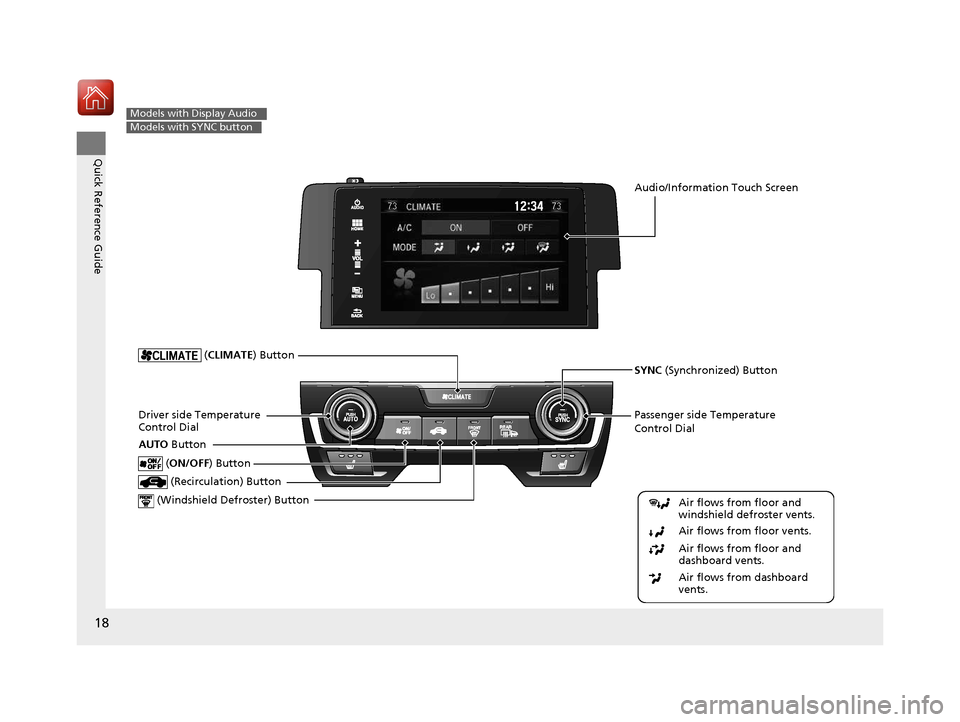
18
Quick Reference Guide
Models with Display Audio
Models with SYNC button
Passenger side Temperature Control Dial
(Windshield Defroster) ButtonDriver side Temperature
Control Dial (Recirculation) Button
(CLIMATE ) Button
(ON/OFF ) Button
AUTO Button
Audio/Information Touch Screen
SYNC (Synchronized) Button
Air flows from floor and
windshield defroster vents.
Air flows from floor vents.
Air flows from floor and
dashboard vents.
Air flows from dashboard
vents.
16 CIVIC 2D HC2 (0A 01 0C)-31TBG6000.book 18 ページ >0>.>/6年>0月>/>0日 金 曜日 午後4時>/6分
Page 27 of 585

26
Quick Reference Guide
Maintenance (P 469)
Under the Hood (P 483)
● Check engine oil, engine coolant, and windshield washer
fluid. Add when necessary.
● Check brake/clutch *
fluid.
● Check the battery condition monthly.
a Pull the hood release handle under the corner of the
dashboard.
b Locate the hood latch lever, pus h the lever in the center to
the right, and lift up the hood.
c When finished, close the hood and make sure it is firmly
locked in place.
Lights (P 498)
● Inspect all lights regularly.
Wiper Blades
(P 507)
● Replace blades if they leave streaks
across the windshield.
Tires (P 510)
● Inspect tires and wheels regularly.
● Check tire pressures regularly.
● Install snow tires for winter driving.
16 CIVIC 2D HC2 (0A 01 0C)-31TBG6000.book 26 ページ >0>.>/6年>0月>/>0日 金 曜日 午後4時>/6分
Page 46 of 585
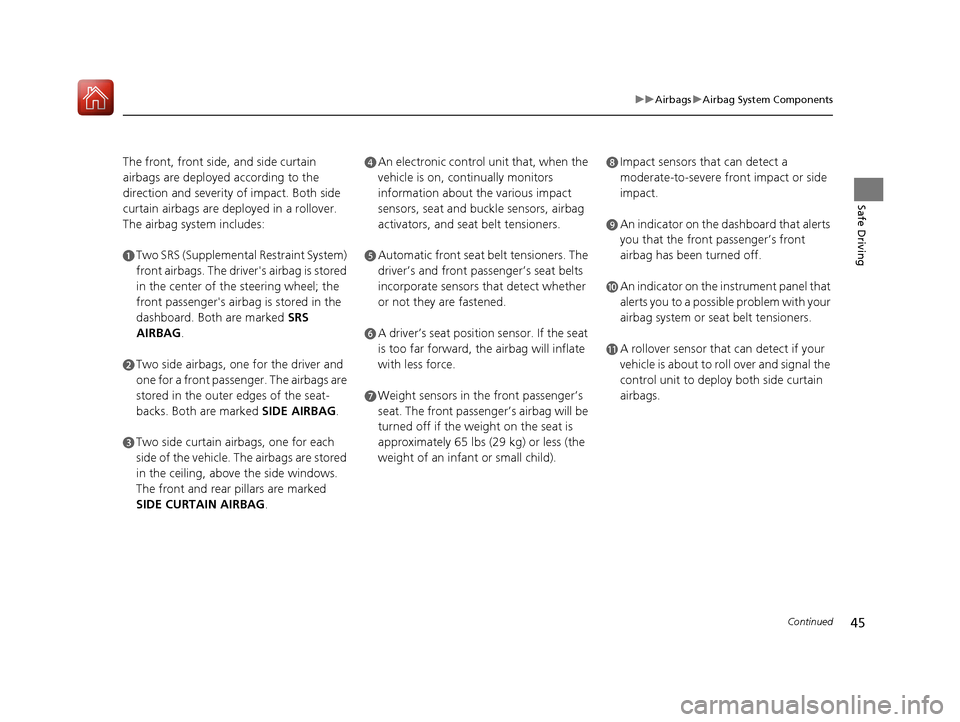
45
uuAirbagsuAirbag System Components
Continued
Safe Driving
The front, front side, and side curtain
airbags are deployed according to the
direction and severity of impact. Both side
curtain airbags are deployed in a rollover.
The airbag system includes:
aTwo SRS (Supplemental Restraint System)
front airbags. The driver's airbag is stored
in the center of the steering wheel; the
front passenger's airbag is stored in the
dashboard. Both are marked SRS
AIRBAG .
bTwo side airbags, one for the driver and
one for a front passenger. The airbags are
stored in the outer edges of the seat-
backs. Both are marked SIDE AIRBAG.
cTwo side curtain ai rbags, one for each
side of the vehicle. The airbags are stored
in the ceiling, above the side windows.
The front and rear pillars are marked
SIDE CURTAIN AIRBAG .
dAn electronic control unit that, when the
vehicle is on, continually monitors
information about the various impact
sensors, seat and buckle sensors, airbag
activators, and seat belt tensioners.
eAutomatic front seat belt tensioners. The
driver’s and front passenger’s seat belts
incorporate sensors that detect whether
or not they are fastened.
fA driver’s seat position sensor. If the seat
is too far forward, the airbag will inflate
with less force.
gWeight sensors in the front passenger’s seat. The front passenger’s airbag will be
turned off if the weight on the seat is
approximately 65 lbs (29 kg) or less (the
weight of an infant or small child).
hImpact sensors that can detect a
moderate-to-severe front impact or side impact.
iAn indicator on the dashboard that alerts
you that the front passenger’s front
airbag has been turned off.
jAn indicator on the instrument panel that
alerts you to a possible problem with your
airbag system or seat belt tensioners.
kA rollover sensor that can detect if your
vehicle is about to ro ll over and signal the
control unit to deploy both side curtain airbags.
16 CIVIC 2D HC2 (0A 01 0C)-31TBG6000.book 45 ページ >0>.>/6年>0月>/>0日 金 曜日 午後4時>/6分
Page 47 of 585
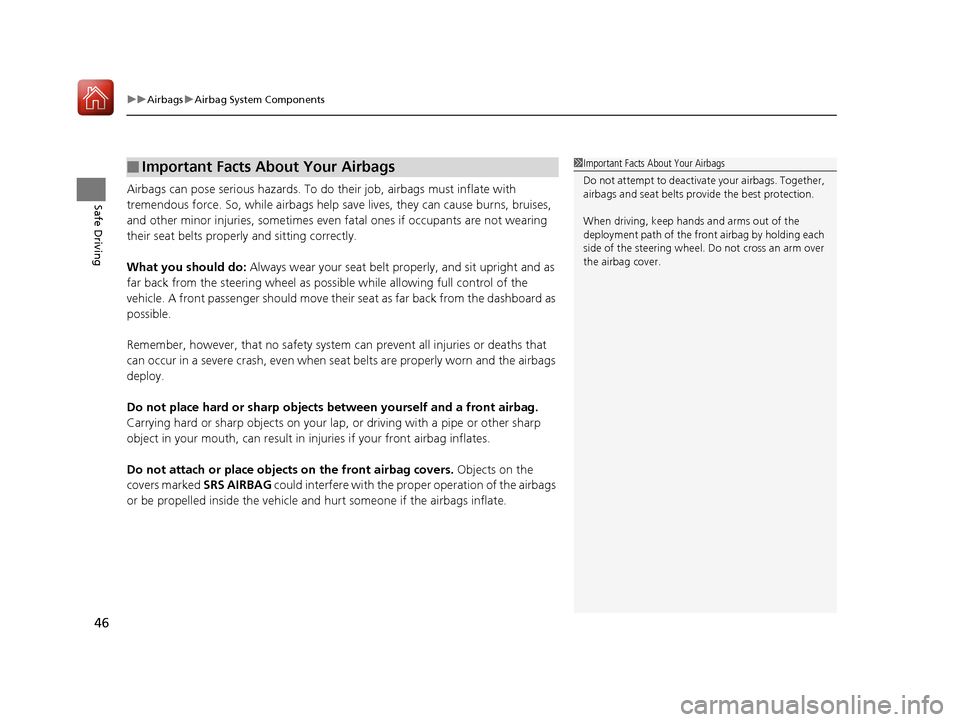
uuAirbagsuAirbag System Components
46
Safe DrivingAirbags can pose serious hazards. To do their job, airbags must inflate with
tremendous force. So, while airbags help save lives, they can cause burns, bruises,
and other minor injuries, sometimes even fatal ones if occupants are not wearing
their seat belts properly and sitting correctly.
What you should do: Always wear your seat belt properly, and sit upright and as
far back from the steering wheel as possi ble while allowing full control of the
vehicle. A front passenger should move thei r seat as far back from the dashboard as
possible.
Remember, however, that no safety system can prevent all injuries or deaths that
can occur in a severe crash, even when seat belts are properly worn and the airbags
deploy.
Do not place hard or sharp objects between yourself and a front airbag.
Carrying hard or sharp objects on your lap, or driving with a pipe or other sharp
object in your mouth, can result in in juries if your front airbag inflates.
Do not attach or place object s on the front airbag covers. Objects on the
covers marked SRS AIRBAG could interfere with the pr oper operation of the airbags
or be propelled inside the vehicle and hurt someone if the airbags inflate.
■Important Facts About Your Airbags1Important Facts About Your Airbags
Do not attempt to deactivate your airbags. Together,
airbags and seat belts pr ovide the best protection.
When driving, keep hand s and arms out of the
deployment path of the front airbag by holding each
side of the steering wheel. Do not cross an arm over
the airbag cover.
16 CIVIC 2D HC2 (0A 01 0C)-31TBG6000.book 46 ページ >0>.>/6年>0月>/>0日 金 曜日 午後4時>/6分
Page 48 of 585
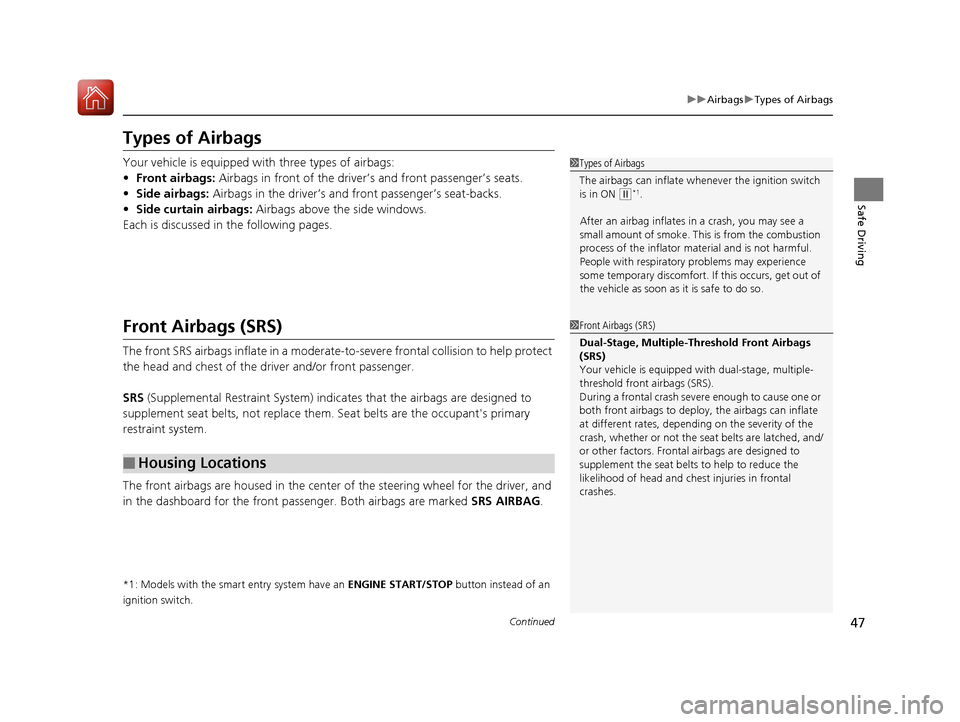
47
uuAirbagsuTypes of Airbags
Continued
Safe Driving
Types of Airbags
Your vehicle is equipped with three types of airbags:
• Front airbags: Airbags in front of the driver’s and front passenger’s seats.
• Side airbags: Airbags in the driver’s and front passenger’s seat-backs.
• Side curtain airbags: Airbags above the side windows.
Each is discussed in the following pages.
Front Airbags (SRS)
The front SRS airbags inflate in a moderate-to-severe frontal collision to help protect
the head and chest of the driver and/or front passenger. SRS (Supplemental Restraint System) indica tes that the airbags are designed to
supplement seat belts, not replace them . Seat belts are the occupant's primary
restraint system.
The front airbags are housed in the center of the steering wheel for the driver, and
in the dashboard for the front pass enger. Both airbags are marked SRS AIRBAG.
*1: Models with the smart entry system have an ENGINE START/STOP button instead of an
ignition switch.
■Housing Locations
1Types of Airbags
The airbags can inflate whenever the ignition switch
is in ON
(w *1
.
After an airbag inflates in a crash, you may see a
small amount of smoke. This is from the combustion
process of the infl ator material and is not harmful.
People with respiratory pr oblems may experience
some temporary discomfort. If this occurs, get out of
the vehicle as soon as it is safe to do so.
1Front Airbags (SRS)
Dual-Stage, Multiple-Threshold Front Airbags
(SRS)
Your vehicle is equipped wi th dual-stage, multiple-
threshold front airbags (SRS).During a frontal crash severe enough to cause one or
both front airbags to deploy, the airbags can inflate
at different rates, dependi ng on the severity of the
crash, whether or not the se at belts are latched, and/
or other factors. Frontal airbags are designed to
supplement the seat belts to help to reduce the
likelihood of head and chest injuries in frontal
crashes.
16 CIVIC 2D HC2 (0A 01 0C)-31TBG6000.book 47 ページ >0>.>/6年>0月>/>0日 金 曜日 午後4時>/6分
Page 51 of 585
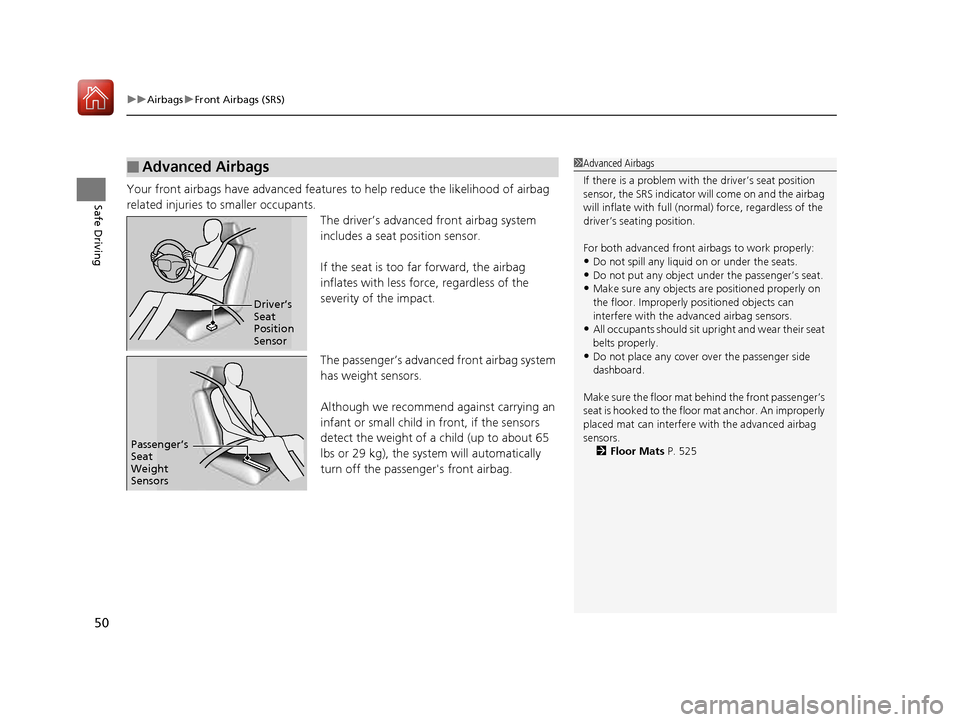
uuAirbagsuFront Airbags (SRS)
50
Safe DrivingYour front airbags have advanced features to help reduce the likelihood of airbag
related injuries to smaller occupants. The driver’s advanced front airbag system
includes a seat position sensor.
If the seat is too far forward, the airbag
inflates with less forc e, regardless of the
severity of the impact.
The passenger’s advanced front airbag system
has weight sensors.
Although we recommend against carrying an
infant or small child in front, if the sensors
detect the weight of a child (up to about 65
lbs or 29 kg), the syst em will automatically
turn off the passenger's front airbag.
■Advanced Airbags1Advanced Airbags
If there is a problem with the driver’s seat position
sensor, the SRS indicator wi ll come on and the airbag
will inflate with full (normal) force, regardless of the
driver’s seating position.
For both advanced front airbags to work properly: • Do not spill any liquid on or under the seats.
• Do not put any object under the passenger’s seat.
• Make sure any objects are positioned properly on the floor. Improperly pos itioned objects can
interfere with the advanced airbag sensors.
• All occupants should sit upri ght and wear their seat
belts properly.
• Do not place any cover over the passenger side dashboard.
Make sure the floor mat behind the front passenger’s
seat is hooked to the floor mat anchor. An improperly
placed mat can interfere with the advanced airbag sensors. 2 Floor Mats P. 525
Driver’s Seat Position
Sensor
Passenger’s Seat
Weight
Sensors
16 CIVIC 2D HC2 (0A 01 0C)-31TBG6000.book 50 ページ >0>.>/6年>0月>/>0日 金 曜日 午後4時>/6分